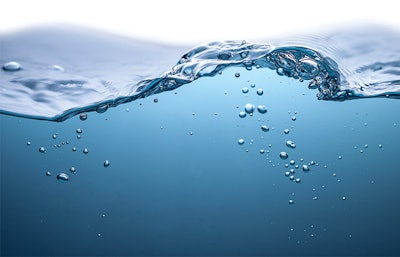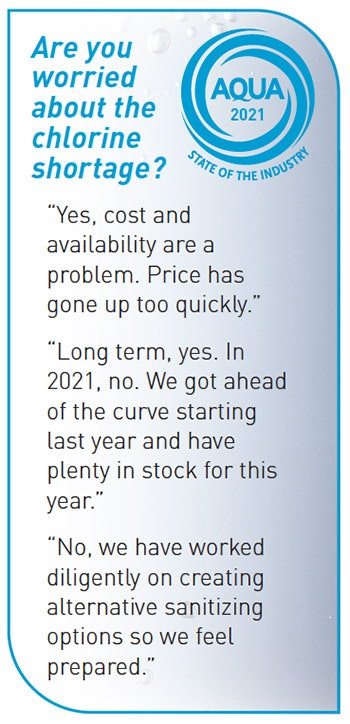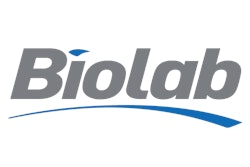

Much of the talk this summer has been about the chlorine shortage. As everyone in the industry is aware, a production facility in Louisiana owned by BioLab was destroyed last fall in a fire, leading to a shortage of trichlor tabs, a very popular form of chlorine for use in swimming pools.
Not everyone uses that form of chlorine to sanitize their pool, of course. Some people use sodium hypochlorite (liquid chlorine), dichlor, calcium hypochlorite, chlorine gas, and then there are those popular machines that use a high-intensity magnetic field to split (NaCl) to produce chlorine, known as salt systems.
So the shortage is unevenly distributed, unevenly felt. The pool industry has always developed a local identity, as builders have tended to specialize in certain types of pools and sanitization methods. So while some service pros have been faced with the scarcity and sharply rising prices of tabs, others have had less of a problem.
For many techs and homeowners, the challenge once again comes down to: How do I use less chlorine? It's a refrain that has echoed through the history of the industry. A large number of pool owners have always been uncomfortable with chlorine, and for obvious reasons — it kills things. We use it in our water in small doses to kill small things, but most consumers are looking for something a little more salubrious to swim in. Or at least a little less noxious.
RELATED: Shortage Update: Chlorine Plant Being Rebuilt, Due Spring 2022
Thus, the rise of products designed to take on part of chlorine's job, so that a pool can use less of it. Which, by coincidence, happens to be the imperative this summer for completely unrelated reasons.
This summer, people who have pools with trichlor tab feeders are looking to use less because the price is up and there may not be enough to supply the summer's needs, and that aligns with a longstanding goal of pool owners in general.
And that should be made clear when making the case for chlorine reduction equipment such as UV, ozone, minerals and AOP systems — that these systems can not only help solve this summer's problem, but the long-term wishes of most pool owners. (Note: There is no product that can take the place of chlorine entirely in its role as a residual sanitizer — except other sanitizers — but there are several technologies that have been proven to allow users to reduce the chlorine level in the pool by up to 90%.)
Let's start with ozone.
OZONE
In simple terms, what an ozone generator does is split oxygen molecules (O2) in two, leaving single molecules that will then attach themselves to other O2 molecules to become ozone, O3, an extremely powerful oxidizer.
Using ozone, users can decrease chlorine residual dramatically, as much as 70% by some estimates, because the ozone is taking on the task of oxidation, the major task of chlorine in the water.
UV
Just like ozone, chlorine reduction is one of the benefi ts of UV sanitation. It has the longstanding reputation of working well with other types of sanitizers and equipment, so it is often combined with minerals, chlorine, bromine, biguanides, ozone and especially salt.
In a UV treatment cell, water passes through and is exposed to a specifi c wavelength of light (254 nanometers). Unlike ozone, whose oxygen molecules tear impurities and alien invaders to shreds, UV's game is to deactivate most of the bacteria and the living entities, such as algae, so they can't grow — and when it comes to biological invaders, growth is what it's all about.
Here, too, the reduction in chlorine usage is substantial, and the necessary amount of free chlorine roaming around the pool can be reduced to a much more comfortable level for those trying to avoid the halogen.
AOP
Although the chemical process of AOP has been around for some time, the application in swimming pools has seen impressive growth in recent years, with more manufacturers getting into the game and promoting the technology.
RELATED: What People Are DOING About the Trichlor Shortage
AOP, or advanced oxidation processing, actually uses both the above technologies in sequence to create hydroxyl radicals, which are short-lived but powerful oxidizers. AOP machines are installed inline, and as water passes through, the unit begins the process by creating ozone, and then hits it with UV light. Through the steps of the AOP process, the single oxygen atoms shed from ozone end up creating hydrogen peroxide. With hydrogen peroxide shouldering the oxidation load, chlorine levels can be dramatically reduced.
MINERALS
Easily the oldest of the popular sanitizing technologies, minerals have been used literally since antiquity to keep water clean. Famously, pioneers headed west in wagon trains used minerals in water barrels to keep their contents fresh.
Mineral sanitizers used in pools are effective killers and like ozone and UV, reduce a pool's dependency on chlorine.
Systems may contain a combination of silver and copper, each with a specific purpose. The silver oxide functions as a sanitizer to eradicate bacteria in the water, while copper functions as an effective algaecide. These, too, are popular units to use in combination with salt systems to reduce the amount of chlorine generation needed from the salt cell.
MAINTENANCE STRATEGIES
While equipment solutions are effective, any chlorine reduction discussion has to include water maintenance strategies, which include frequent testing and monitoring of pH, the use of low but consistent levels of stabilizer, regular shocking with a chlorine or non-chlorine product like potassium monopersulfate, preventative levels of algaecide to head off blooms in dead areas of the pool, and the use of enzymes and phosphate removal products to help ease the burden on chlorine.
The temporary shortage of chlorine caused by the unfortunate loss of a manufacturing plant has focused the spotlight squarely on the sanitizer that has been the backbone of the industry from its inception. This summer, while supplies of chlorine tabs are scarce, it's in everyone's best interest to reduce the amount of chlorine used in pools. This goal aligns with longstanding concerns that are already in the customer's mind, and represents a selling opportunity for all segments of the industry — builders, retailers and service providers alike.
This article first appeared in the July 2021 issue of AQUA Magazine — the top resource for retailers, builders and service pros in the pool and spa industry. Subscriptions to the print magazine are free to all industry professionals. Click here to subscribe.












































